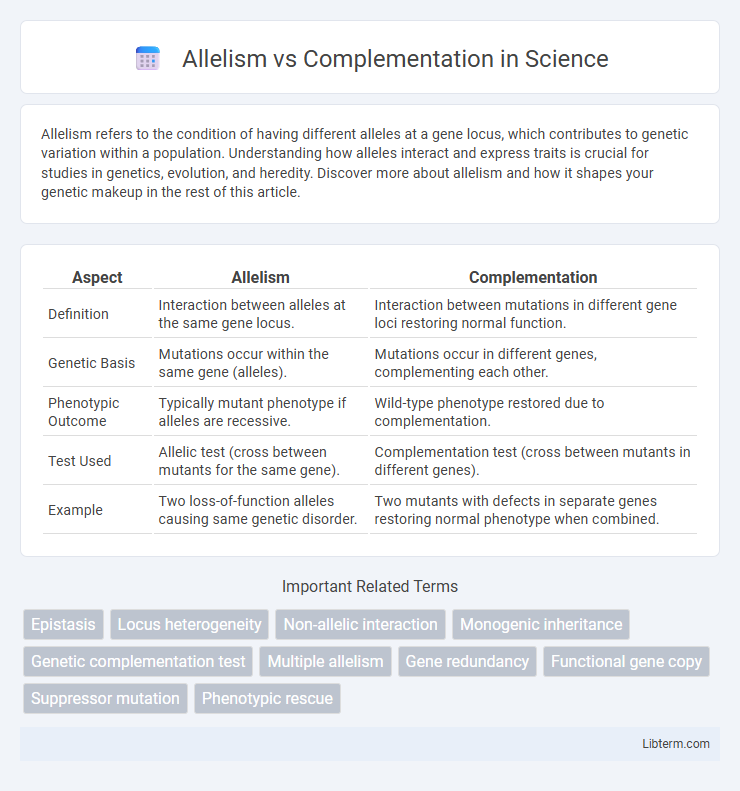Allelism refers to the condition of having different alleles at a gene locus, which contributes to genetic variation within a population. Understanding how alleles interact and express traits is crucial for studies in genetics, evolution, and heredity. Discover more about allelism and how it shapes your genetic makeup in the rest of this article.
Table of Comparison
| Aspect | Allelism | Complementation |
|---|---|---|
| Definition | Interaction between alleles at the same gene locus. | Interaction between mutations in different gene loci restoring normal function. |
| Genetic Basis | Mutations occur within the same gene (alleles). | Mutations occur in different genes, complementing each other. |
| Phenotypic Outcome | Typically mutant phenotype if alleles are recessive. | Wild-type phenotype restored due to complementation. |
| Test Used | Allelic test (cross between mutants for the same gene). | Complementation test (cross between mutants in different genes). |
| Example | Two loss-of-function alleles causing same genetic disorder. | Two mutants with defects in separate genes restoring normal phenotype when combined. |
Understanding Allelism: A Genetic Overview
Allelism refers to the relationship between different alleles of the same gene that can influence the same trait or phenotype, revealing variations within a single gene locus. Understanding allelism involves examining how these alleles interact, whether they are dominant, recessive, or show incomplete dominance, which directly affects gene expression and inheritance patterns. This genetic concept is crucial for interpreting phenotypic outcomes and differentiating from complementation, where mutations in different genes produce similar phenotypes but do not involve allelic variation.
Defining Complementation in Genetics
Complementation in genetics occurs when two mutations in different genes produce a wild-type phenotype when combined in a heterozygote, indicating that each mutation affects a separate functional gene. This phenomenon helps distinguish whether mutations are allelic (within the same gene) or non-allelic, as non-complementation suggests allelism. Complementation tests are critical for mapping genetic pathways and understanding gene interactions in functional genomics.
Key Differences Between Allelism and Complementation
Allelism refers to the interaction between different alleles of the same gene, determining whether two mutations are in the same genetic locus. Complementation occurs when mutations in different genes restore a wild-type phenotype in a heterozygous organism, indicating non-allelism. The key difference lies in allelism testing for mutations within the same gene, while complementation analysis identifies mutations in separate genes affecting related functions.
Genetic Basis: Mutations and Gene Function
Allelism involves mutations within the same gene locus, leading to different alleles that can affect gene function variably, such as loss-of-function or gain-of-function mutations. Complementation occurs when mutations in different genes produce similar phenotypes, and their union restores normal gene function, indicating that the mutations are in separate loci. Understanding the genetic basis of allelism and complementation is critical for mapping gene interactions and functional pathways in genetic analysis.
Experimental Approaches: The Complementation Test
The complementation test is a foundational experimental approach used to determine whether mutations causing a similar phenotype occur in the same gene (allelism) or in different genes. By crossing two mutants and analyzing the phenotype of the heterozygous offspring, researchers can observe if complementation occurs, indicating mutations lie in separate genes, or if the mutant phenotype persists, suggesting allelic mutations in the same gene. This test is crucial in genetic mapping and functional analysis to distinguish allelic variation from genetic complementation.
Case Studies: Allelism vs Complementation in Model Organisms
Case studies in model organisms like Drosophila melanogaster and Saccharomyces cerevisiae reveal critical distinctions between allelism and complementation which aid in genetic mapping and functional analysis. In Drosophila, allelism tests determine if mutations reside in the same gene by crossing mutants and observing phenotypes, while complementation assays in yeast reveal if mutations in different genes can restore a wild-type function. These approaches elucidate genetic pathways and identify gene interactions crucial for understanding hereditary traits and molecular functions.
Molecular Mechanisms Underlying Allelism
Allelic mutations occur within the same gene locus and can result in varied molecular outcomes such as missense, nonsense, or frameshift mutations, each altering gene function differently. These mutations affect protein structure or expression, influencing phenotypic manifestation and gene product functionality in genetic disorders. Understanding the molecular basis of allelism is crucial for interpreting genetic interactions, mutation effects, and the resulting complementation patterns in molecular genetics.
Complementation and Genetic Pathway Mapping
Complementation occurs when two mutations in different genes restore a wild-type phenotype in a diploid organism, providing critical insight into gene function through genetic pathway mapping. This process helps identify whether mutations affect the same gene or separate genes, allowing researchers to construct detailed maps of genetic interactions and pathways. Genetic pathway mapping via complementation tests reveals functional relationships between genes, enabling the dissection of complex biological processes at the molecular level.
Practical Applications in Genetic Research
Allelism testing is essential in genetic research for identifying whether different mutations occur in the same gene, enabling precise gene mapping and diagnosis of hereditary diseases. Complementation analysis, widely used in functional genomics, determines if different mutations can restore normal phenotype when combined, facilitating the discovery of gene function and interaction pathways. These techniques accelerate the development of targeted gene therapies and improve genetic screening programs by clarifying gene relationships and mutation effects.
Summary: Implications of Allelism and Complementation
Allelism determines whether mutations occur within the same gene, impacting genetic variability and mutation mapping, while complementation tests reveal whether mutations complement each other's function by occurring in different genes, crucial for functional gene analysis. These concepts influence genetic screening, functional genomics, and mutation characterization, guiding research in gene interactions and hereditary disease mechanisms. Understanding allelism and complementation facilitates targeted gene identification and enhances precision in genetic engineering and therapeutic development.
Allelism Infographic

 libterm.com
libterm.com